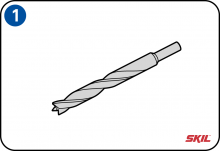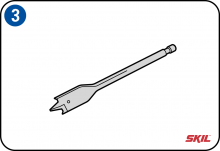-
Wood drill
A standard wood drill is used to make holes of up to 10 mm diameter in all kinds of wood. Wood drills have the advantage of a sharp central tip. This makes it easy to hold your power drill on exactly the right spot without the drill sliding away.
-
Auger bit
An auger bit has a sharp pointed tip with a tapered screw thread which allows the drill to be centered very precisely. The hardened, threaded tip ensures that the hole you drill is very precise, smooth and burr-free. Auger bits are suitable for drilling in softwood, European hardwood and beams.
-
Flat bit
A flat bit is only used for larger holes, from 11 mm diameter. To drill a clean, smooth hole it’s best to drill until the tip of the bit just protrudes through the other side of the workpiece. Then turn the workpiece round and finish the hole from the other side. Flat bits have a centering tip and sharp cutting edges on the two opposite sides of the blade. This drill bit is used for larger holes, both across the wood grain or into sawed edges of beams and planks. Always use a higher drilling speed with this kind of drill bit.
-
Countersinking bit
A countersinking bit is used when you want to countersink the screw head so that it is flush with or just below the surface of the wood. The screw hole is first drilled with a standard bit, after which the countersinking bit is used to countersink the hole to the required depth. If you want to make the screw completely invisible, make the countersunk hole slightly deeper and fill above the screw head with wood filler paste, a plug or a piece of dowel.
-
Adjustable holesaw
An adjustable holesaw has a pointed central tip and a cutting blade which can be adjusted to different diameters. When using a holesaw you should fix your drill in a stand or otherwise clamp the workpiece firmly on the bench.
-
Holesaw
For even bigger holes in wood than you can make with a flat bit, you can use a holesaw. The cutting edge of a holesaw looks like a sawblade which is bent into a circle. You first drill a centering hole with the central drill bit, after which you cut the final hole using the sawblade part of the bit. You can also get multi-holesaws which are not only suitable for hardwood but also for brick, plasterboard, laminate, plastic and similar materials.
-
Plug cutter
You can cut a plug to conceal a screw hole, but the vibration of the drill means it’s often difficult to make a perfectly shaped plug. For the best result, you can use a special plug cutter in a stationary drill or in a drill fitted in a stand.







